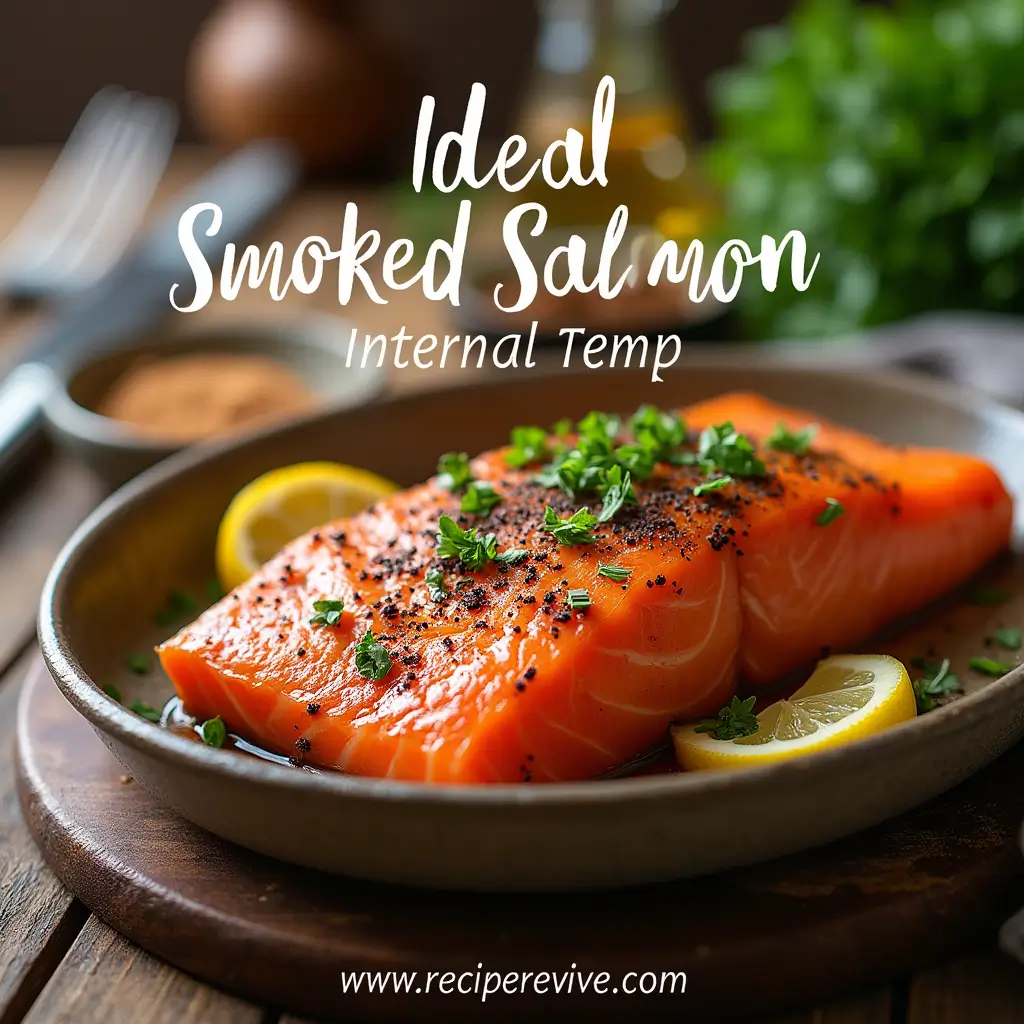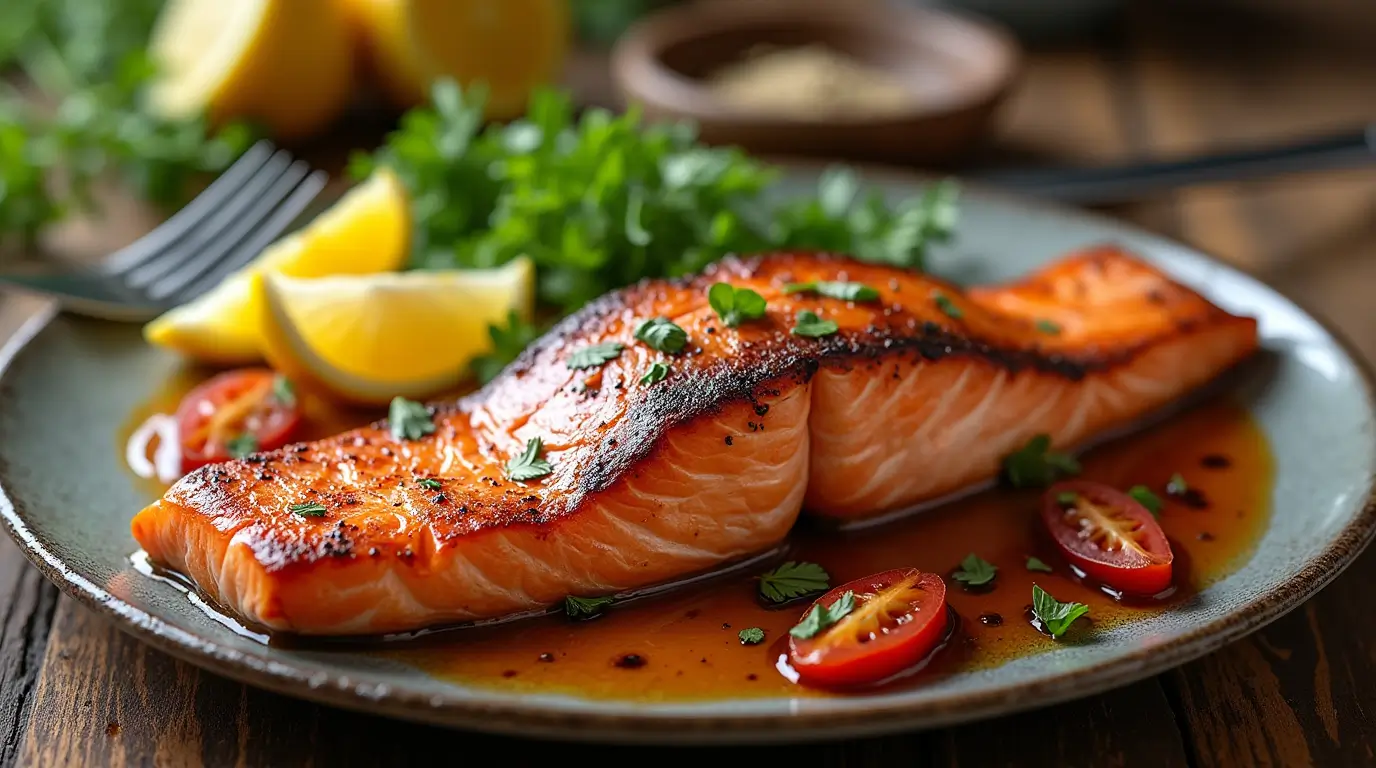Ideal Smoked Salmon Internal Temp
Smoking salmon at home is a joy, but getting the internal temperature right is key. It’s all about finding that perfect balance. This ensures the salmon is both delicious and safe to eat. Whether it’s for a big meal or a cozy breakfast, the right temperature makes all the difference.
In this guide, we’ll explore the science behind smoked salmon. We’ll look at the best internal temperatures, curing methods, and smoking techniques. By the end, you’ll know how to make amazing smoked salmon at home. Your dishes will look great and taste even better, impressing everyone.
Table of Contents
Smoked Salmon: A Delicacy with Rich History
Smoking salmon is a tradition that has lasted for centuries. It’s not just about adding flavor. It’s a way to keep food fresh that has been passed down for generations.
Curing and Smoking: Time-Honored Preservation Methods
Cured fish has been important for many cultures for centuries. Salt in the cure pulls out moisture and harmful microbes from the fish. As the bad bacteria die, good bacteria move in, eating the sugar. This makes the environment too acidic for harmful bacteria, helping to keep the fish fresh.
Smoking is another effective way to preserve food. The wood smoke has compounds that kill microbes and slow down bad flavors.
The Science Behind Salt and Sugar Curing
The science of salt and sugar curing is interesting. Salt pulls out moisture and kills harmful bacteria. Then, good bacteria like lactobacillus come in, eating the sugar. This makes the environment even more hostile to bad bacteria, improving preservation.
“Smoking meat and fish is another tried-and-true way to preserve food, not just a way to add complex smoky flavors. Wood smoke contains chemicals that slow the growth of microbes, and these antimicrobial compounds act as a disinfectant to help prevent spoilage and slow the development of rancid flavors.”
Smoked salmon’s rich history and traditional methods make it special. By understanding curing and smoking, we can see the skill and care that goes into making this seafood favorite.
Understanding Hot and Cold Smoking
The art of smoking salmon involves two distinct techniques: cold smoking and hot smoking. Each method offers unique benefits and considerations for the discerning palate.
Cold Smoking: Preserving Fish Through Low Temperatures
Cold smoking is a meticulous process where the ambient cooking temperature remains between 68-86°F (20-30°C) for 6-12 hours. During this time, the salmon’s flesh loses some of its moisture, resulting in a denser, more concentrated flavor. The challenge with cold smoking is keeping the meat out of the temperature danger zone (40-140°F [4-60°C]) for an extended period, as this can potentially harbor harmful microbes.
Hot Smoking: Cooking Salmon to Safe Internal Temp.
In contrast, hot smoking takes place at higher temperatures, typically ranging from 150-170°F (66-77°C). This elevated cooking environment effectively kills any existing microbes, ensuring the salmon is safe to consume. The higher heat also cooks the fish, resulting in a flaky, tender texture that is often preferred by many food enthusiasts.
Whether you opt for the delicate flavors of cold smoking salmon or the bold, smoky notes of hot smoking salmon, understanding the nuances of these salmon smoking techniques is crucial for achieving the perfect smoking temperatures for salmon.
“The key to exceptional smoked salmon lies in the delicate balance between preserving the natural flavors and ensuring food safety.”
Salmon Internal Temp: From Raw to Perfectly Cooked
To get the perfect smoked salmon, it’s key to watch the fish’s internal temperature. The salmon’s texture and doneness change with temperature. Let’s see how different temperatures affect the salmon:
- 70°F: The salmon is soft, slick, smooth, and translucent.
- 100°F: The salmon becomes soft, slick, smooth, and translucent with a wet surface.
- 110°F: The protein starts to shrink, making the flesh firmer, opaque, and juicy.
- 120°F: The flesh shrinks more, becoming resilient, less slick, and more fibrous, opaque, and juicy when chewed or cut.
- 130°F: Sheets of protein start to separate, making it flaky, and enzymes that weaken fibers become inactive.
- 140°F: Proteins shrink more, making the texture firm, fibrous, and fragile, with little juice left.
- 150°F: The protein gets even firmer, drier, flakier, and more fragile.
- 160°F: The flesh becomes stiff and dry, with all protein fibers denatured and coagulated.
The best cook temperature for salmon is 125°F. This makes the salmon flakier, more moist, and tender. It ensures the salmon is cooked just right, with a delicate texture and great flavor.
“Using a food thermometer to measure the internal temperature of the thickest portion of salmon is the most accurate method to determine doneness.”
Monitoring Smoked Salmon Internal Temp.
It’s key to track the internal temperature of your smoked salmon and the smoker. The ThermaQ dual-channel alarm thermometer is great for this. It lets you watch both the smoker’s temperature and the salmon’s internal temp at the same time.
The ThermaQ has alarms for low and high temperatures. This helps keep your smoker at the best 150-170°F (66-77°C) range for hot smoking salmon. A digital meat thermometer with a probe is vital. It helps you know when your salmon is done, at 130-135°F (54-57°C), for a moist and tender texture.
“Proper use of a digital meat thermometer, both for the smoker’s internal temperature and the salmon’s internal temperature, is crucial for perfect smoked salmon.”
Keeping an eye on the smoking thermometer for salmon and smoked salmon internal temp monitoring is important. It makes sure your salmon hits the safe internal temperature of 145°F (63°C) without getting too dry. The food safety thermometer for smoking makes it easy to get that perfect smoked salmon texture you love.

Smoked Salmon Internal Temp for Optimal Texture
The internal temperature of smoked salmon is key for the perfect texture. To keep it soft and dense, smoke it at about 150°F (66°C). Pull it when it hits 120°F (49°C).
Harold McGee, a food scientist, says fish should cook between 120-135°F (49-57°C). This ensures the protein stays tender and juicy. Cooking it too long makes it dry and tough.
“The ideal internal temperature for smoked salmon is 120-135°F (49-57°C), where the tender protein firms up but remains juicy.”
To get the best texture, use a smoking thermometer to check the internal temperature. Keeping it in the ideal range makes your smoked salmon soft, dense, and flavorful.
The smoking method also affects the texture. Cold smoking makes it firmer, while hot smoking makes it tender and flaky.
Knowing the right temperature and smoking method lets you make smoked salmon with the perfect texture every time.
Preventing the Dreaded Albumin
Smoked salmon lovers know the problem of albumin – a white liquid protein that can appear during smoking. It’s harmless but not pretty. Luckily, there are easy ways to stop it and enjoy your smoked salmon.
Wet Brining and Pellicle Formation
Begin by wet brining your salmon in water, kosher salt, and brown sugar for up to 12 hours. This makes the fats in the fish solid, keeping albumin from escaping. Also, letting the salmon chill uncovered for up to 24 hours creates a pellicle. This pellicle acts as a barrier to keep albumin inside.
Low and Slow Smoking Technique
Smoke the salmon at 180°F (82°C), not the usual 225°F (107°C). The low and slow method cooks the salmon gently. This keeps the fats and proteins together, reducing albumin leakage.
Using wet brining, pellicle formation, and low and slow smoking can prevent albumin. This way, you can enjoy your smoked salmon without any unwanted white liquid.
Smoked Salmon Internal Temp for Doneness
Getting the perfect smoked salmon is all about the internal temperature. It should be between 120-135°F (49-57°C). This ensures the salmon is tender, juicy, and has a great texture.
Rare to Well-Done: A Temperature Guide
Here’s how to get your salmon just right based on its internal temperature:
- Rare: 120°F (49°C)
- Medium-Rare: 125-130°F (52-54°C)
- Medium: 135-140°F (57-60°C)
- Well-Done: 140-150°F (60-66°C)
Don’t cook the salmon too long. The USDA says it should be at least 145°F (63°C) for safety. But for the best taste, stop smoking when it hits 120-135°F (49-57°C).
| Doneness | Internal Temperature |
|---|---|
| Rare | 120°F (49°C) |
| Medium-Rare | 125-130°F (52-54°C) |
| Medium | 135-140°F (57-60°C) |
| Well-Done | 140-150°F (60-66°C) |
Keep an eye on the smoked salmon internal temp for doneness. This way, your salmon will be tender, flaky, and full of flavor. Learning the salmon doneness temperatures is crucial for a delicious salmon cooking temp guide.
Tips for Smokey Smoked Salmon Success
Getting the perfect smoked salmon takes planning. The secret is in the brining and pellicle steps. Wet brine the salmon for 4-12 hours. Then, let it chill uncovered for up to 24 hours to form a pellicle. This keeps the salmon moist and helps it soak up smoke.
Planning Ahead for Brining and Pellicle
Brining and pellicle formation are key for great smoked salmon. Wet brine the salmon for 4-12 hours, based on its thickness. Use a brine mix of 2.25 lbs kosher salt, 1 lb brown sugar, and 1 Tbsp Cure #1 for every 4-5 lbs of fish.
After brining, rinse the fillets well. Then, soak them in cold water for 60-120 minutes. This helps remove extra salt.
Selecting High-Quality Salmon
Choosing fresh, high-quality salmon is vital for tasty smoked salmon. Go for Atlantic or King salmon. They have more fat, which is good for smoking. Avoid leaner salmon like Sockeye, as they can dry out.
With the right salmon and careful prep, you’re set for delicious smoked salmon.

“The best smoked salmon starts with the right ingredients and thorough preparation. By taking the time to brine and develop a pellicle, you’ll lock in moisture and maximize smoke absorption for truly delicious results.”
Conclusion
Smoked salmon is a tasty, traditional dish you can make at home. With the right steps, you can get a smoky flavor and tender texture. You’ll need to know about curing, smoking, and using tools like a digital thermometer.
Whether you like the soft taste of cold-smoked salmon or the firmer hot-smoked version, watch the temperature. Keep it between 140°F and 150°F for the best taste and safety. A good meat thermometer helps you check the salmon’s temperature.
By using the tips from this article, you’ll make amazing smoked salmon. It will impress everyone. Enjoy the smoky taste and feel proud of your cooking skills.
FAQ
What is the safe internal temperature for smoked salmon?
What are the key steps in curing and smoking salmon?
What’s the difference between cold smoking and hot smoking salmon?
How does salmon’s internal temperature affect its texture and doneness?
What equipment is recommended for monitoring smoked salmon’s internal temp?
How can I prevent the unsightly albumin from appearing on smoked salmon?
What factors are important for achieving the best smoked salmon texture and flavor?
Share Your Experience with the Recipe
Perfect Balance of Taste and Professionalism
The instructions were detailed and clear! I learned so much about the internal temperature and smoking methods. The salmon came out moist and flavorful. I highly recommend this to anyone who loves cooking at home!
Perfectly Smoked Salmon with Easy-to-Follow Instructions
This guide made smoking salmon at home simple and enjoyable. The step-by-step instructions, especially on internal temperature and brining techniques, helped me create salmon with great flavor and texture.
Best Way to Smoke Salmon at Home!
This guide was incredibly helpful! I learned so much about the perfect internal temperature for smoking salmon. The temperature tips were spot on, and the result was tender and delicious salmon. I will definitely be doing this again!
Great Results but Timing Is Key
The smoking process was great, but timing is crucial to prevent the salmon from drying out. The tips on monitoring internal temperature were super useful. The final result was fantastic, and the flavor was perfect!

